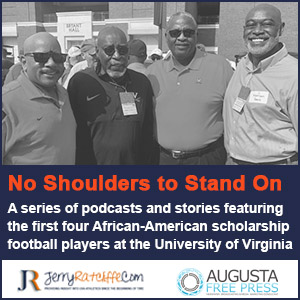Bronco: It’s more fun playing than watching; always put your best 11 on the field
By Jerry Ratcliffe
 Bronco Mendenhall learned early in his coaching career to put the best 11 players on the field, regardless of the configuration on any given week. That’s what he did last Saturday in Virginia’s 43-0, season-opening win over visiting William & Mary.
Bronco Mendenhall learned early in his coaching career to put the best 11 players on the field, regardless of the configuration on any given week. That’s what he did last Saturday in Virginia’s 43-0, season-opening win over visiting William & Mary.
It’s exactly what Mendenhall will do this Saturday morning when the Big Ten’s Illinois come to Scott Stadium for an 11 a.m. kickoff.
Virginia’s new depth chart on Monday afternoon reflected the philosophy in anticipation of the Fightin’ Illini, who were upset at home, 37-30, by UTSA over the weekend, a week removed from a mild upset over division foe Nebraska.
Most of the changes on this week’s depth chart were on the defensive side of the ball, particularly in the secondary as Mendenhall and his staff continue to experiment with the 3-3-5 scheme, along with the 3-4. In reality, Virginia, like most college teams, have been playing nickel packages for years in order to defend all the varied spread offenses.
Mendenhall learned the 3-3-5 concepts as defensive coordinator under Rocky Long at New Mexico in the late ‘90s.
The two-deep reflects those changes as the Virginia coach attempts to put the best 11 defenders on the field, but also as an adaptation to match what Illinois’ offense brings to town. Illinois is a typical Big Ten team that often uses two tight ends and likes to play power football.
“It’s more of the opponent,” Mendenhall said in Monday’s presser. “We love flexibility and we love adaptability.”
Nick Grant, who started at corner last week, is listed as safety, while De’Vante Cross, who started at strong safety last week, is now listed as the nickel.
Joey Blount, has moved from free to strong safety, and Louisville transfer Anthony Johnson is listed at boundary corner in place of Darrius Bratton, who has switched to field corner behind Fentrell Cypress.
Grant, a senior, said he has played safety before. Mendenhall believes these movements give the secondary more depth.
“What we’ve learned _ to win the Coastal Division and to make it through the ACC Championship game and to go to the Orange Bowl _ is that depth in the secondary is really important, so players cross-training and being available at multiple positions, helps with our depth,” Mendenhall said.
The same philosophy, in terms of getting the best players on the field, regardless of position, holds true for Virginia’s offense as well. Blessed with a high number of versatile players who are capable of adding to the offensive production, Mendenhall and his staff went to a number of players in the win over William & Mary.
There wasn’t much traditional about it. While the revised system, an enhancement of what UVA’s offense had been in the past, posted more than 500 yards and a 43 points.
Eight different players ran the ball: Brennan Armstrong (QB), Iraken Armstead (QB), Jacob Rodriguez (QB) and running backs Wayne Taulapapa, Devin Darrington, Ronnie Walker Jr., and Mike Hollins, along with Keytaon Thompson, who is simply listed as “Football Player,” a guy who can line up almost at any skilled position in the offense.
While UVA’s running game wasn’t quite as traditional as most fans expected, it still accounted for 206 yards and three touchdowns.
In addition, 11 different Cavaliers caught passes for another 339 yards and two scores. Oh, and UVA receivers posted 144 yards after catch on those 21 receptions.
Dontayvion Wicks was targeted the most, eight times, caught four passes for 94 yards. Meanwhile, Thompson was targeted six times, caught five, for 66 yards (including 38 YAC), and Billy Kemp was targeted six times, caught four, for 55 yards.
While the offense may appear complicated with so many moving parts and lots and lots of motion, Armstrong said it wasn’t complicated to him.
I asked Mendenhall on Monday if the present system is just an offshoot of what Virginia was running before, and because he has an unusually high amount of versatility among his skill players.
“It’s more of the second, and it’s back to the same philosophy that we’re using defensively (best 11),” Mendenhall answered. “It’s just the maximization of resources, right, so we’re looking at every good football player on our team, and we’ve got four different quarterbacks that all can do different things, and there’s no reason they all have to play quarterback.
“We’re maximizing any good player on our team, putting him out there in as many unique, creative, but productive ways as we can, and so the concepts remain relatively the same _ not always _ but relatively the same. The personnel and maybe the formations that we use, those are kind of where the main differences come.”
Was the constant shuffling of quarterbacks and other skilled players disruptive in terms of developing a smoother rhythm, which caused the offense to start slower against William & Mary, or was it just the first game kind of deal?
“There are certain plays where we are using different quarterbacks,” Mendenhall said. “Man, I think the play count and the volume isn’t enough to truly affect what we’re doing mostly and I think for the possible benefit, it’s a good trade. So I believe in the idea.”
Because UVA’s four running backs only had 11 of the 32 carries in the game, was that a reflection on their abilities, or rather a reflection on how talented the three quarterbacks have? The QBs had 16 rushes and Thompson had the other four.
“I really like our running backs, so it’s not a reflection on that,” Mendenhall said. “Those (quarterback runs) are difficult to prepare for and hard to identify what personnel group is it, or who might carry the ball. Those are all things that are challenging [to defenses].
“Hopefully it adds some value to our offense, but also some of those kids are really good carrying the football. They’re good throwing it. They’re good football players. When they’ve played that position, the game seems to be slower for them from the beginning with their training, and so they’re more ready to play and play early.”
True freshman Rodriguez, who is a product of a program in Texas known for developing valuable quarterbacks, rushed for 31 yards and Armstead, 54.
Rodriguez is still considered a quarterback, but while he’s competing at that position, it doesn’t mean he can’t help the offense.
“There’s no reason he can’t help us and play football,” Mendenhall said. “We have a saying here that playing is more fun than watching, so he’s still a quarterback, but that doesn’t mean he can’t carry the ball and he can’t do other things while he’s becoming our quarterback. But we saw it in the spring and I was really impressed then.”








